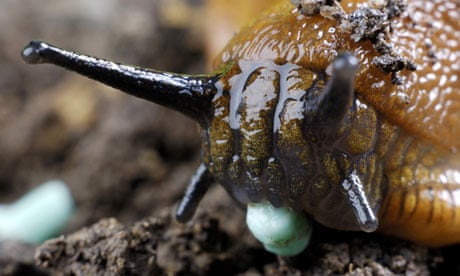Slug poison was found in one in eight rivers and reservoirs used for drinking water in England and Wales according to the Environment Agency's (EA) most recent survey, prompting environmentalists to call for greater use of natural predators instead of chemicals.
The EA told the Guardian that between 2009 and 2011 concentrations of metaldehyde, used by farmers to protect their crops from slugs, were found in 81 of 647 reservoirs, rivers and groundwater from which drinking water is sourced. The chemical is almost impossible to remove from drinking water using standard treatments.
But the agency said the levels of metaldehyde were not a human or environmental health concern.
Levels spiked in late 2011 and persisted into 2012 due to wet weather creating runoff and ideal slug breeding conditions. In November, levels 100 times higher than EU regulations were detected at a water treatment intake on the River Stour in Essex. Pesticide industry representative Paul Fogg said pellet use during summer and autumn of 2011 was at the highest level ever.
Pond Conservation director Jeremy Biggs said current methods for limiting runoff were ineffective, although he added that he held few concerns about human or environmental health.
.png?width=445&dpr=1&s=none)
"Runoff of metaldehyde is proving difficult to control. At the moment there isn't a technique for stopping the runoff other than not using it," said Biggs. "You'd need to drink 1,000 litres of water every day of your life to be affected," he said. He said toxicity was very low once the chemical was in water and he had not seen any research to indicate that it represented a threat to the environment.
EU standards of 0.1 micrograms per litre are not set on a health basis but at a near zero value reflecting legislation that pesticides and molluscicides (snail baits and pellets) should not be present in drinking water at any level. Currently the EA encourages the agriculture industry to self-regulate on the issue.
Green party leader Natalie Bennett told the Guardian the agriculture industry's inability to control metaldehyde meant a rethink of slug control methods was needed and regulations should be enforced.
"The current voluntary system isn't working, we've got a threat, if hard to quantify, to human and ecosystem health. It's clear that regulation to protect both is needed," she said.
Restoring populations of natural slug predators, such as hedgehogs, frogs wild birds, predatory nematodes and carabid beetles, represented an approach that would work for farmers and for the wider environment, said Bennett.
"We clearly have to take a broader view of farms as part of our environment, and understand that they have to work with and support our natural ecosystems, not attempt to manage unfavourable aspects of them with chemical blankets."
Buglife chief executive Matt Shardlow said the invertebrate conservation trust held concerns over metaldehyde's impact on land. The chemical could be inadvertently used in areas where endangered species, such as the UK's largest land snail, the Roman snail, would be affected.
Slugs are one of the UK's most damaging agricultural pests, said Fogg. Their populations are closely linked to rainfall with damp summers and mild winters causing optimum breeding conditions.
"Slugs, subject to the right environmental conditions, can cause devastating damage and almost complete crop loss," he said.
During these times, farmers used metaldehyde pellets to avoid losing some or all of their crops to slugs. Fogg said that once the pellets were applied to fields, whether they stayed there or ended up in waterways was "in the lap of the gods".
"If you have above average rainfall then you can get water running across the surface of fields or through field drainage systems, that's when potentially you can get movement of metaldehyde from fields into water," said Fogg. Farmers may then have to reapply pellets that are washed away, further compounding the issue.

Comments (…)
Sign in or create your Guardian account to join the discussion